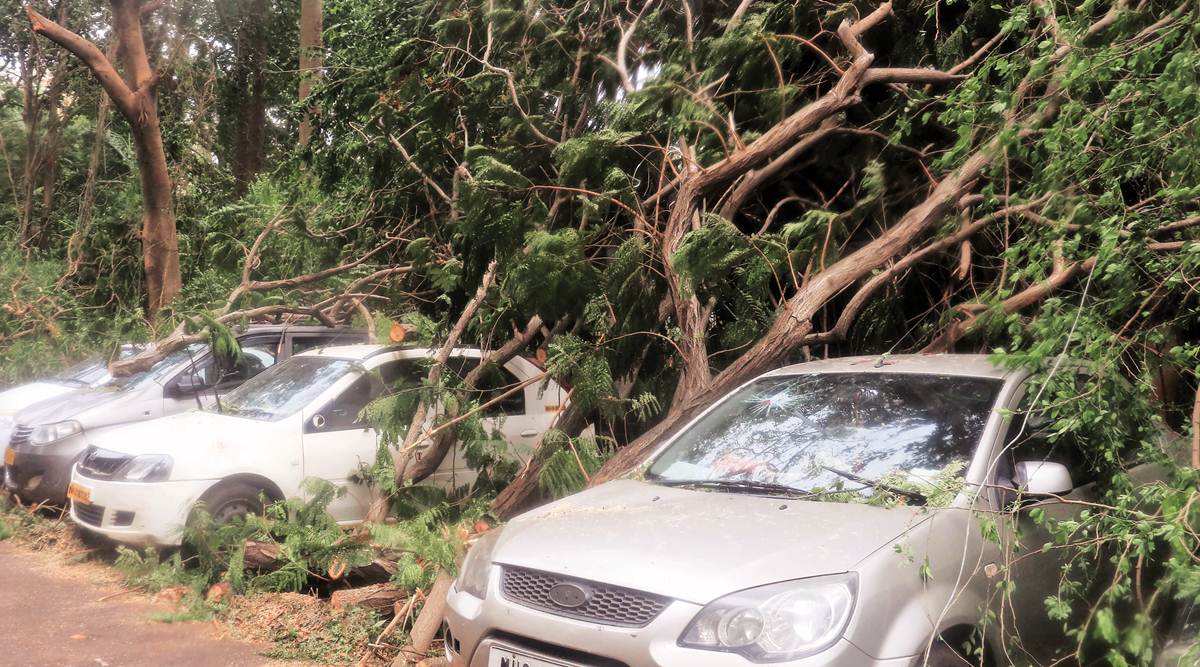 Fallen trees on a road in Mumbai. (Express photo by Ganesh Shirsekar)
Fallen trees on a road in Mumbai. (Express photo by Ganesh Shirsekar) Pointing to a higher frequency of extreme weather events and indicating a rise in the same over the coming decades across the country and the western coast, an analysis by environmental think tank the Council on Energy, Environment and Water (CEEW) has mentioned that the yearly average of Indian districts affected by cyclones tripled and the cyclone frequency doubled after 2005.
The CEEW said the country, in the last 50 years, has also recorded a 12-fold surge in the number of associated cyclonic events such as extreme rainfall, floods, sea-level rise, and thunderstorms and that the frequency and intensity of extreme weather events over the country as well as the Western coast is likely to increase over the coming decades.
In Gujarat, as many as 29 districts are exposed to extreme climate events, with districts in Saurashtra region such as Amreli, Gir Somnath, Junagadh, and Porbandar being “especially vulnerable to intensified cyclones and storm surges”, which have increased three-fold between 1970 and 2019, according to the council.
“These are worrying signs, given that Arabian Sea cyclones have battered India’s west coast at the rate of one per year since 2018, a frequency not seen in five decades. The development of the cyclones is also linked to micro-climatic warming over land in these regions. These districts have seen hotter summers, warmer days and more frequent droughts. What usually happens in coastal areas is that the heat over the land is pulled into the ocean which is usually cooler. With the land temperature increasing locally, this leads to neighbouring oceans pulling this heat. The oceans themselves are also heating due to global warming. The land surface micro-climatic changes are contributing to the intensification of these storms into cyclones,” said Programme Lead at CEEW, Abinash Mohanty.
According to the CEEW analysis, it is also increasingly common for one set of Gujarat districts to experience droughts while another faces floods in the same season. Drought-prone districts like Jamnagar, Rajkot, Surat, and Valsad have witnessed a shift towards extreme floods and storm surges in the last decade. These changing patterns are due to microclimatic changes that are triggered by local climate change drivers such as land-use-surface change, deforestation, encroachments upon wetlands and water bodies. Their unpredictability makes disaster management harder and places severe strain on the state’s economy.
The analysis also points to Maharashtra as a vulnerable state which has been affected most by droughts with a seven-fold increase in the past 50 years, affecting more than 80 percent of its districts. “In the last decade, districts such as Aurangabad, Mumbai, Nashik, Pune, Thane are witnessing a micro-climatic shift to a dry summer climate zone, resulting in an increase in cyclonic disturbances. This has led to storm surges and incessant rainfall and flooding. There has been a six-fold increase in frequency of extreme flood events in Maharashtra in the last 50 years… The main hotspots of these extreme flood events are the districts of Mumbai, Thane and Ratnagiri. Mumbai alone has witnessed a three-fold increase in the frequency of extreme flood events in the last 50 years,” it stated.
In Goa, there has been a four-fold increase in storm surge and cyclone events in the last 50 years. Cyclone-associated events have also increased six-fold since 2005.
Arunabha Ghosh, CEO at CEEW, said, “Cyclone Tauktae has once again brought the climate crisis to the forefront during the ongoing pandemic. Climate-vulnerable states such as Gujarat need to have a razor-sharp focus on building climate resilience, especially at the local and regional levels. Further, they must invest in cost-effective (and nature-based) resilient infrastructure.”
“The fact is that the implementation of the second phase of the National Cyclone Risk Mitigation Project, approved in 2015, has been lagging on the western coast. The Eastern coast, and especially states like Odisha have fared well in the implementation of this programme in terms of cyclone preparedness including the building of shelters. The projects along the western coast were to be completed by 2019, but the states here have missed this deadline, which has now been extended to 2022,” Ghosh said.
- The Indian Express website has been rated GREEN for its credibility and trustworthiness by Newsguard, a global service that rates news sources for their journalistic standards.

